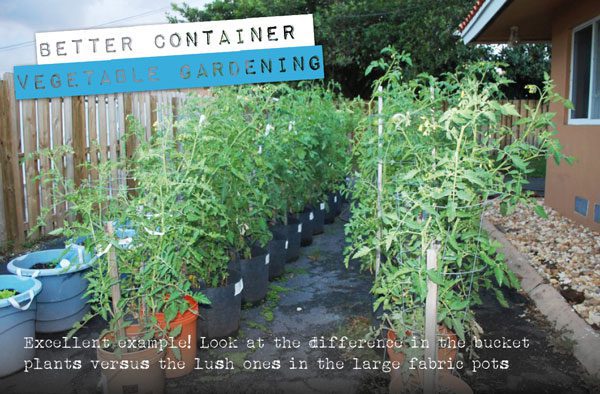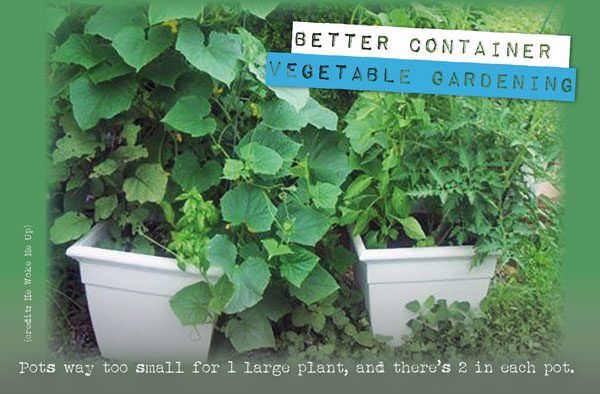Many people have taken up container vegetable gardening in the past few years. It’s popular for many reasons, including the fact that it can mean less work than a large garden in the yard. There’s less weeding to do and growing in containers makes gardening more accessible to seniors and people with physical disabilities.
Buying containers can be quite expensive, especially when they’re big enough to hold a full-size tomato plant. Luckily, many things we have lying around the house can be turned into plant pots!
Upcycling is resourceful, eco-conscious, and trendy, but you can’t just use anything for container vegetable gardening. Are you providing the plant with optimum growing conditions? Or have you reduced it’s vigor, immunity, and fruiting capabilities? Sometimes, penny pinching winds up carrying a bigger price tag in the end.
Container Vegetable Gardening is About the Plants!
- They have no patience for being cute or stylish.
- Don’t expect them to be convenient, or to keep the deck clean and dry.
- Never ask them to tolerate cramped, dry, or wet conditions.
- You can’t expect plants grown for food to do a dollar’s work for a dime.

To perform at their very best, plants have certain requirements. Sufficient space above and below the soil line, good nutrition, good support, good drainage, fresh water, consistent moisture, and lots of sunshine.
Give Them Space
Yes, you can cram 4-6 flowering annuals into a container that’s 18-24 inches wide. You’ll have to water a lot, but it looks so cool!
You can’t do this with plants grown for food. Even in a raised bed – overcrowding and insufficient root space will lead to a reduced harvest and fruit size.
When there isn’t good air flow through the stems and leaves, you’re creating the perfect environment for disease to set in. If you live in a humid climate, forget about keeping tomatoes free of disease caused by lots of rain, or heavy dew and chilly night air. With excellent air flow, you’ll find that tomatoes in containers are less prone to blight and leaf spot because the leaves and soil surface can dry easily.
The Root Zone
Many plants will survive in a container much smaller than the space the root system would have occupied in the ground. Still, the plant will never reach its full size. The less room the roots have, the closer to a bonsai specimen you’ll get. And a scrawny one at that.
There will be less branching, and consequently, less flowering and fruit. The fruits it does produce will be smaller than the same plant grown where its roots can develop properly. Sure, you can grow patio or cherry tomatoes in a tiny container, but will that give you a slicing tomato? You can’t make a BLT from itty bitty fruits!

Moisture retention is a problem in vegetable container gardening. Especially in plastic planters!
The more roots in the growth media, the more water and nutrients you must give. Plan on watering at least twice a day. If your container garden gets too dry, you could end up with blossom end rot, blossom loss, and growing tip or stem damage.
Fighting Drought with Containers
Using containers with no drainage hole isn’t the solution. Too much water leads to issues like cracked tomatoes, not-so-hot chili peppers, suffocation, and root rot.
If you’re trying to keep the patio or deck clean and dry – put a saucer or tray under it to catch the dirty water. Plants that can’t breathe produce little to no food at all, not to mention being downright hideous looking.
Then there are self-watering planters. Even these can cause you crop problems. The water down there is stagnant. There’s no airflow, and it’s hot as hell inside that plastic tote bin when it’s 80-90 degrees outside.
Is your container garden sitting on hot pavement? This anaerobic condition breeds harmful bacteria, which love hot, wet conditions.
Advanced Container Vegetable Gardening
How would you feel about defying the laws of container gardening and getting a better harvest? You can, even without drainage holes and by using topsoil and compost and/or cow manure. Now you’ll have excellent moisture retention with good drainage and airflow in a food-safe container that you can leave outdoors all winter.
The container will last anywhere from three to ten years depending on what brand you buy. Warning: it won’t be chic, and it will make your wood deck wet constantly without a saucer. But your veggies will be ecstatic, as long as you don’t overcrowd them. Bonus: you won’t have very many weeds to pull.
The secret? Fabric pots and planters. The frugal gardeners out there will scour the world to find the cheapest ones possible. Sorry, but that’s not the economical approach to this scenario. You’ll be replacing your pots and planters pretty regularly.
Smart Pots are the longest lasting ones available, giving you seven to ten years of durable use. There’s a reason they cost more than those lower-priced knock-offs. Thin fabric and lower quality materials (like recycled plastic bottle fabrics) will not hold up well. Some will only last one summer or two, so in the end, you’ll spend much more than using the best option from the start.

Fabric containers come in all sorts of sizes with varying widths and depths. I’ve grown tomatoes in them, and the results were phenomenal! After a couple of years growing everything in straw bales, I’m switching to everything but tomatoes grown in Smart Pots.
Growing in a 70/30 mix of black topsoil to composted cow manure gives you excellent airflow for roots while maintaining both drainage and moisture retention. It’s a lot cheaper as a growing medium than potting mixes, and plants go nuts in it.
I know a #30 is great for a huge tomato plant, but what about everything else? Figuring out how many pots and what sizes are needed for each plant is essential!
Reusable Soil
One other cost-saving benefit to container gardening using real soil is you don’t have to replace it every year. Over the winter, the top 2-3 inches of dirt in the Smart Pot blows away, but that’s okay. You want to replenish the compost/cow manure content each time you plant to provide the best growing environment.
I shovel out about 60% of what’s in the container into a wheelbarrow to amend it. This makes it a lot easier to mix the two together with a shovel and saves the container walls from wear and tear too.
Once you see how much faster and bigger your plants grow – you’ll never go back to plastic for growing veggies.
Last updated by Catherine Sherriffs on 06/07/2020.